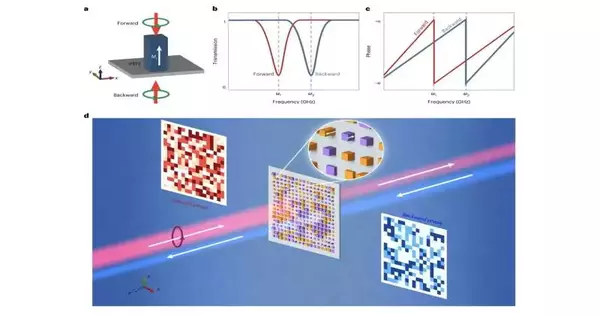Two-dimensional (2D) or planar versions of metamaterials, known as metasurfaces, display characteristics that are uncommon in natural materials. These materials, which can typically be produced using well-known fabrication techniques because they are flat, may aid in regulating the propagation of electromagnetic waves in a variety of devices.
The majority of metasurfaces adhere to the principles set forth by the so-called Lorentz reciprocity theorem, which in essence means that they display properties that are symmetrically aligned with the direction of electromagnetic wave propagation. A new class of metasurfaces that defies the Lorentz reciprocity theorem is known as non-reciprocal metasurfaces.
Non-reciprocal metasurfaces could encode optical functions on waves that are propagating both forward and backward, in contrast to conventional metasurfaces. The development of several technologies, such as non-reciprocal antennas or protective structures known as radomes, which are intended to maintain the operation of radar antennas or wireless communication systems, could be especially aided by this crucial characteristic.
“We demonstrate that they can be used for on-demand bidirectional phase modulation, which provides non-reciprocal functions such as microwave isolation, non-reciprocal beam steering, non-reciprocal focusing, and non-reciprocal holography,”
Yang, Qin and their colleagues wrote in their paper.
A new magnetic non-reciprocal metasurface was recently created by researchers at the Massachusetts Institute of Technology (MIT) and the University of Electronic Science and Technology of China. This surface could be used to build new non-reciprocal devices with a variety of functionalities. The self-biased magnetic meta-atoms made of lanthanum (La)-doped barium hexaferrite (BaFe12O19) were used to create the metasurface, which was first described in Nature Electronics.
In their paper, Weihao Yang, Jun Qin, and their colleagues described a self-biased non-reciprocal metasurface based on magnetic meta-atoms made from la-doped BaFe12O19. The transmittance of the metasurface can reach 77 percent, and its operation angle is 64 degrees.”.
In essence, the non-reciprocal metasurface created by the team can be individually magnetized in a variety of directions by each of the meta-atoms that are present. The researchers were able to engineer their metasurfaces to achieve bidirectional, non-reciprocal phase-gradient profiles by leveraging this important aspect of their design.
They then demonstrated in initial experiments that the resulting metasurfaces can enable a wide range of functionalities that may be useful for the creation of various devices and electronic components. They could be utilized, for example, to accomplish full-duplex transmission, circulation, and electromagnetic wave isolation.
“We show that they can be used for on-demand bidirectional phase modulation, which provides non-reciprocal functionalities including microwave isolation, non-reciprocal beam steering, non-reciprocal focusing, and non-reciprocal holography,” Yang, Qin, and their colleagues wrote in their paper. “By utilizing various self-biased magnetic materials, the method might also be expanded to megahertz and optical frequencies.”.
Future non-reciprocal electronics, such as non-reciprocal antennas and radomes, may be made possible by Yang, Qin, and their colleagues’ new non-reciprocal metasurfaces. Additionally, the creative design they develop might encourage other teams to develop other metasurfaces based on self-biased magnetic meta-atoms that are similar to their own.
In their subsequent research, the scientists might use various self-biased meta-atoms to increase the operating frequency of their metasurfaces, potentially covering megahertz to optical wave frequencies. They also intend to further enhance the functionality of devices based on their metasurfaces, for example, by lowering the efficiency, insertion, and reflection losses linked to their current design.
More information: Weihao Yang et al, A self-biased non-reciprocal magnetic metasurface for bidirectional phase modulation, Nature Electronics (2023). DOI: 10.1038/s41928-023-00936-w





